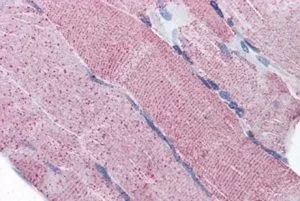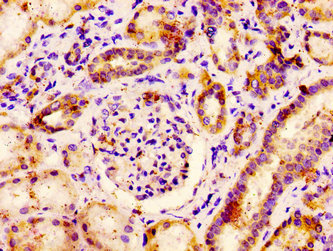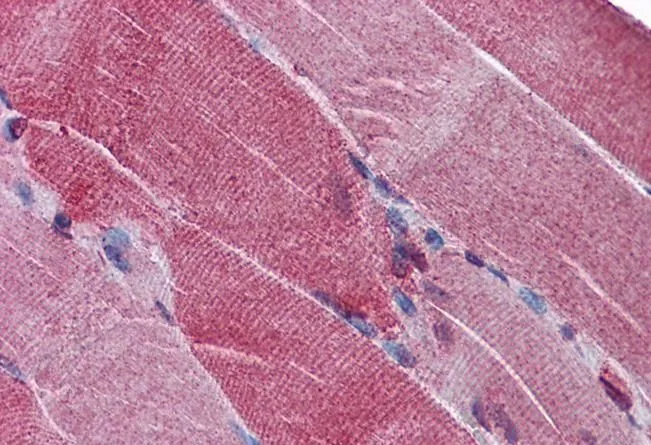
IHC-P analysis of human skeletal muscle using GTX88576 PACE4 antibody, Internal. Antigen retrieval : citrate buffer pH 6 Dilution : 5microg/ml
PACE4 antibody, Internal
GTX88576
ApplicationsImmunoHistoChemistry, ImmunoHistoChemistry Paraffin
Product group Antibodies
TargetPCSK6
Overview
- SupplierGeneTex
- Product NamePACE4 antibody, Internal
- Delivery Days Customer9
- Application Supplier NoteIHC-P: 5-10microg/ml. *Optimal dilutions/concentrations should be determined by the researcher.Not tested in other applications.
- ApplicationsImmunoHistoChemistry, ImmunoHistoChemistry Paraffin
- CertificationResearch Use Only
- ClonalityPolyclonal
- Concentration0.50 mg/ml
- ConjugateUnconjugated
- Gene ID5046
- Target namePCSK6
- Target descriptionproprotein convertase subtilisin/kexin type 6
- Target synonymsPACE4, SPC4, proprotein convertase subtilisin/kexin type 6, paired basic amino acid cleaving enzyme 4, paired basic amino acid cleaving system 4, subtilisin-like proprotein convertase 4, subtilisin/kexin-like protease PACE4
- HostGoat
- IsotypeIgG
- Protein IDP29122
- Protein NameProprotein convertase subtilisin/kexin type 6
- Scientific DescriptionThis gene encodes a member of the subtilisin-like proprotein convertase family, which includes proteases that process protein and peptide precursors trafficking through regulated or constitutive branches of the secretory pathway. The encoded protein undergoes an initial autocatalytic processing event in the ER to generate a heterodimer which exits the ER and sorts to the trans-Golgi network where a second autocatalytic event takes place and the catalytic activity is acquired. The encoded protease is constitutively secreted into the extracellular matrix and expressed in many tissues, including neuroendocrine, liver, gut, and brain. This gene encodes one of the seven basic amino acid-specific members which cleave their substrates at single or paired basic residues. Some of its substrates include transforming growth factor beta related proteins, proalbumin, and von Willebrand factor. This gene is thought to play a role in tumor progression and left-right patterning. Alternatively spliced transcript variants encoding different isoforms have been identified. [provided by RefSeq, Feb 2014]
- Storage Instruction-20°C or -80°C,2°C to 8°C
- UNSPSC12352203






